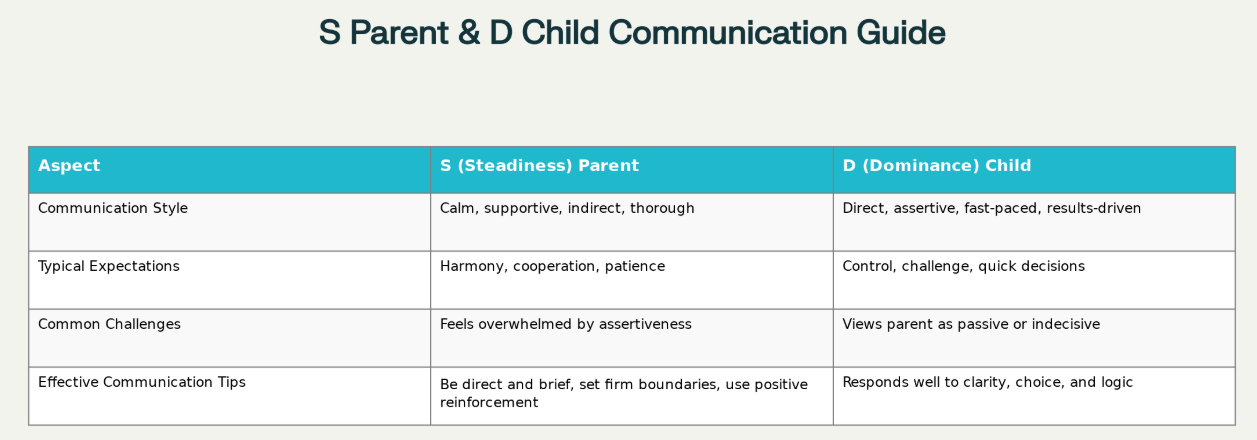Understanding the S-D Dynamic in Parenting: How S Parents Can Connect Well with D Children
How S Parents Can Connect Well with D Children

Have you ever felt like your parenting style just doesn’t quite “click” with your child’s personality? If you’re a calm, steady parent who values harmony, but your child is a natural leader craving independence and control, understanding each other can often feel like a challenge. This dynamic is especially common in families where steady (S) parents are raising dominant (D) children—a relationship that can bring both friction and tremendous growth.
The DISC personality model offers valuable insights into these differences, providing a practical roadmap for improving communication and strengthening bonds. This article explores key strategies for S parents to connect effectively with their D children and sets realistic expectations to foster a healthy father-son relationship.
Please remember, while DISC provides helpful guidelines, personality and behavior are complex and highly individual. Use this framework as a tool and adapt it thoughtfully to your unique family.
What Are DISC S and D Personalities?
DISC is one of the most widely used personality profiling models globally. It categorises behaviours into four main styles:
- D (Dominance): Assertive, results-driven, competitive, and direct. D individuals like to take charge, seek challenges, and prefer fast-paced decision-making.
- I (Influence): Social, enthusiastic, and people-oriented.
- S (Steadiness): Calm, reliable, patient, and supportive. S types prize stability, harmony, and tend to avoid conflict.
- C (Conscientiousness): Detail-focused, analytical, and systematic.
In parenting, knowing whether you or your child is S or D can illuminate why certain interactions work well and why others lead to misunderstandings.
Common Challenges Between S Parents and D Children
The S parents’ desire for peace, routine, and emotional connection can come into conflict with the D child’s action-oriented, control-seeking nature. These differences may lead to:
- The S parent feels overwhelmed by the D child’s energetic assertiveness or impatience.
- The D child perceives the S parent’s calm approach as indecisive or overly accommodating.
- Potential tension when the D child challenges boundaries that the S parent hesitates to enforce.
- Communication gaps, where emotional appeals fall flat on the goal-driven D child.
Recognising these tendencies helps reduce frustration and opens the door to more effective strategies.

Effective Communication Tips for Steady (S) Parents
If you are an S parent raising a D child, adjusting your communication style can make a significant difference. Here are strategies that many parents find helpful:
Be Direct and Brief
D children prefer clear, straightforward messages. Avoid lengthy explanations or emotional appeals that may seem overwhelming or slow. Instead, communicate your expectations clearly and succinctly.
Example: Instead of “I feel worried when you don’t listen, and I need you to pay more attention,” say “I need you to listen when I talk. Let’s agree on that.”
Explain the “Why” with Logic and Results
Ds respect logic and want to understand the purpose or consequence behind your requests. This motivates compliance and cooperation.
Example: “Finish your homework now so you can have free time later.”
Set Firm Boundaries with Consistent Consequences
D children test limits naturally. Be clear about rules and consistently enforce consequences without wavering. This builds respect and trust.
Don’t Take Their Bluntness Personally
D children communicate directly and sometimes bluntly, not out of disrespect but from a results-focused mindset. Learn to separate their style from your feelings.
Offer Choices to Satisfy Their Need for Control
Providing options gives D children a sense of autonomy while still maintaining parental structure.
Example: “You can do chores before or after dinner—your choice.”
Balance Accommodation with Assertiveness
Avoid the temptation to always accommodate for the sake of peace. Assert yourself firmly where it matters, while maintaining your supportive, calm demeanour.
Use Positive Reinforcement
Acknowledge when your child follows through or shows progress. Praise reinforces positive behaviour without confrontation.
What S Parents Can Expect From D Children
- Understanding what to anticipate from your D child makes for better preparation and response:
- They will likely be assertive, energetic, and thrive on challenges.
- Pushing boundaries and testing authority is part of their developmental drive.
- They prefer action and results over emotional reassurance or long talks.
- Clear, confident leadership from parents earns their respect more than passive accommodation.
- Though less overt in emotional expression, they do care deeply.
Navigating the Father-Son S-D Relationship
Traditionally, father-son relationships can magnify the S-D dynamic because societal expectations emphasise strength, control, and independence. The S father, valuing harmony and patience, may feel tested by the son’s dominant need for control and challenge.
However, the S father plays a vital role by:
- Providing steady emotional grounding from which the D son can explore independence
- Modelling thoughtful patience alongside clear firmness
- Encouraging respectful and honest communication
- Being a calm, reliable anchor amidst high-energy dynamics
Achieving balance in this dynamic often means learning to communicate with clarity and confidence, without compromising your steady nature.
Adapting DISC Insights to Your Family Reality
No personality model, including DISC, can capture the full richness of any individual or family relationship. The greatest value lies in using these insights as one lens among many to observe, understand, and adapt.
Try experimenting with the strategies above in ways that fit your child’s unique temperament and your family’s values. Keep an open mind, maintain patience, and be willing to adjust based on feedback and experience.
How DISC Understanding Transforms Parenting Relationships
Applying DISC to parenting shifts it from reactive to proactive. It moves understanding from “Why doesn’t my child listen?” to “How can I best communicate so my child hears me?”
Many parents report a deeper connection, less conflict, and more respect as they learn to meet their children where they are rather than forcing them into their own style.
Parenting as a Journey of Growth
Raising a D child as an S parent offers opportunities for growth on both sides. It is a dance between action and stability, challenge and calm, directness and support.
Approach this journey with curiosity, compassion, and flexibility. Embrace your child’s strengths and needs, and use your own steady nature as a strong foundation. Together, you can build a relationship based on mutual respect, understanding, and love that lasts a lifetime.
Share Your Experience
Have you experienced the S-D dynamic in your family? What strategies helped you bridge differences? Share your story or questions in the comments below—we’d love to learn from your experience!





